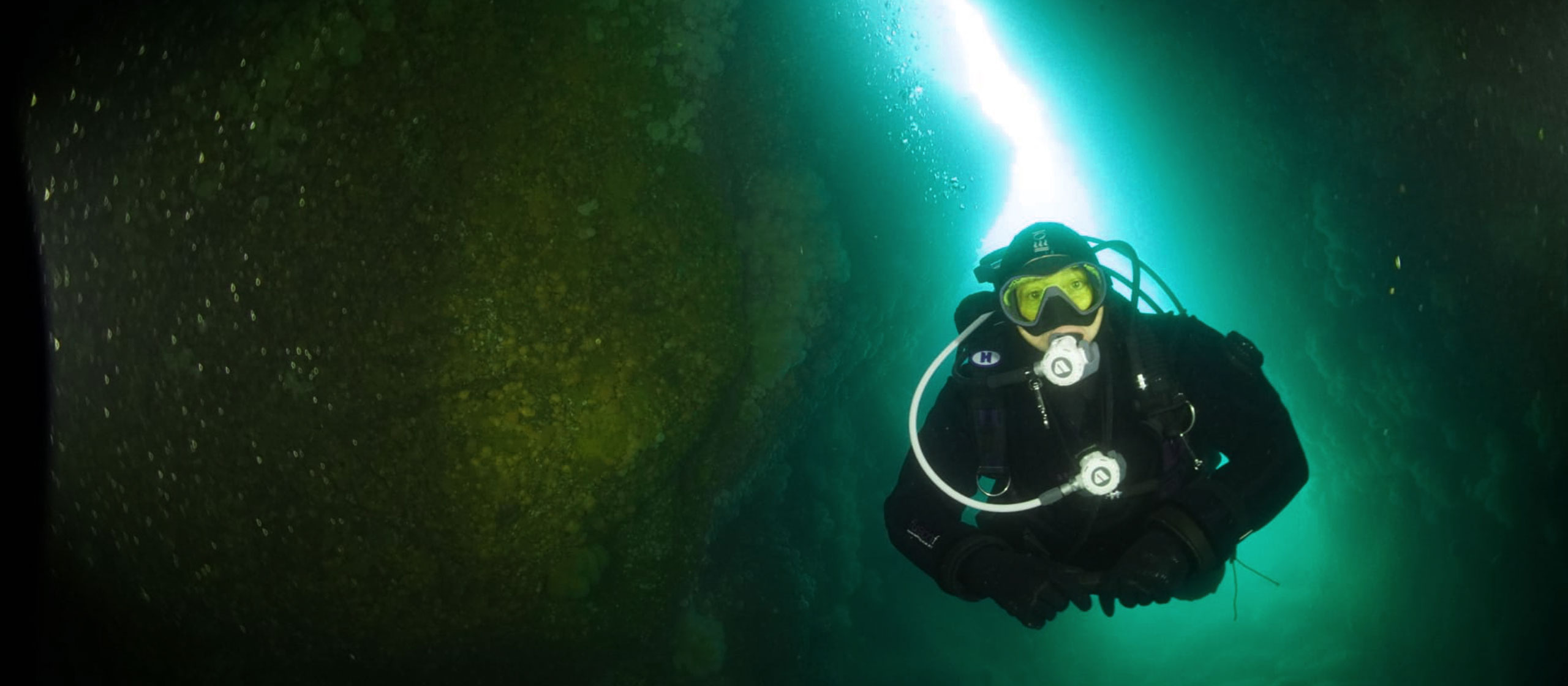Last Summer I Saw a Diver Die
Until 2023, I was among those divers who had never witnessed a severe incident in scuba diving. Certainly, I’ve encountered challenging dives, including a few where doubts about reaching the surface crept in. I’ve experienced stress and faltered during training exercises, only to be rescued by an instructor’s timely intervention. I’ve managed urgent issues with my own students, preventing escalation and have rescued a few divers in minor emergencies. I’ve also witnessed other divers having significant scares or concerns about subtle symptoms. However, in 17 years of diving, I had never been confronted with major injuries or fatalities. That changed last year.
As a scuba diving instructor and clinical psychologist, I have dedicated myself to developing services and resources for divers affected by adverse events. On my website, I’ve established a self-help area, offering insights on maintaining psychological health after such incidents. The following account is shared from my dual perspective: reflecting both my personal experience as a witness and rescuer, and as a psychologist specialising in diving-related trauma. Given the severity and impact of the event, and the purpose of this article, I will offer limited detail. For the same reasons I will share only my part of the story. I acknowledge that there are many people who will have their own unique experience of the event. My intention in using soft-focus on the incident is to be sensitive to the reader and respectful to all those involved.
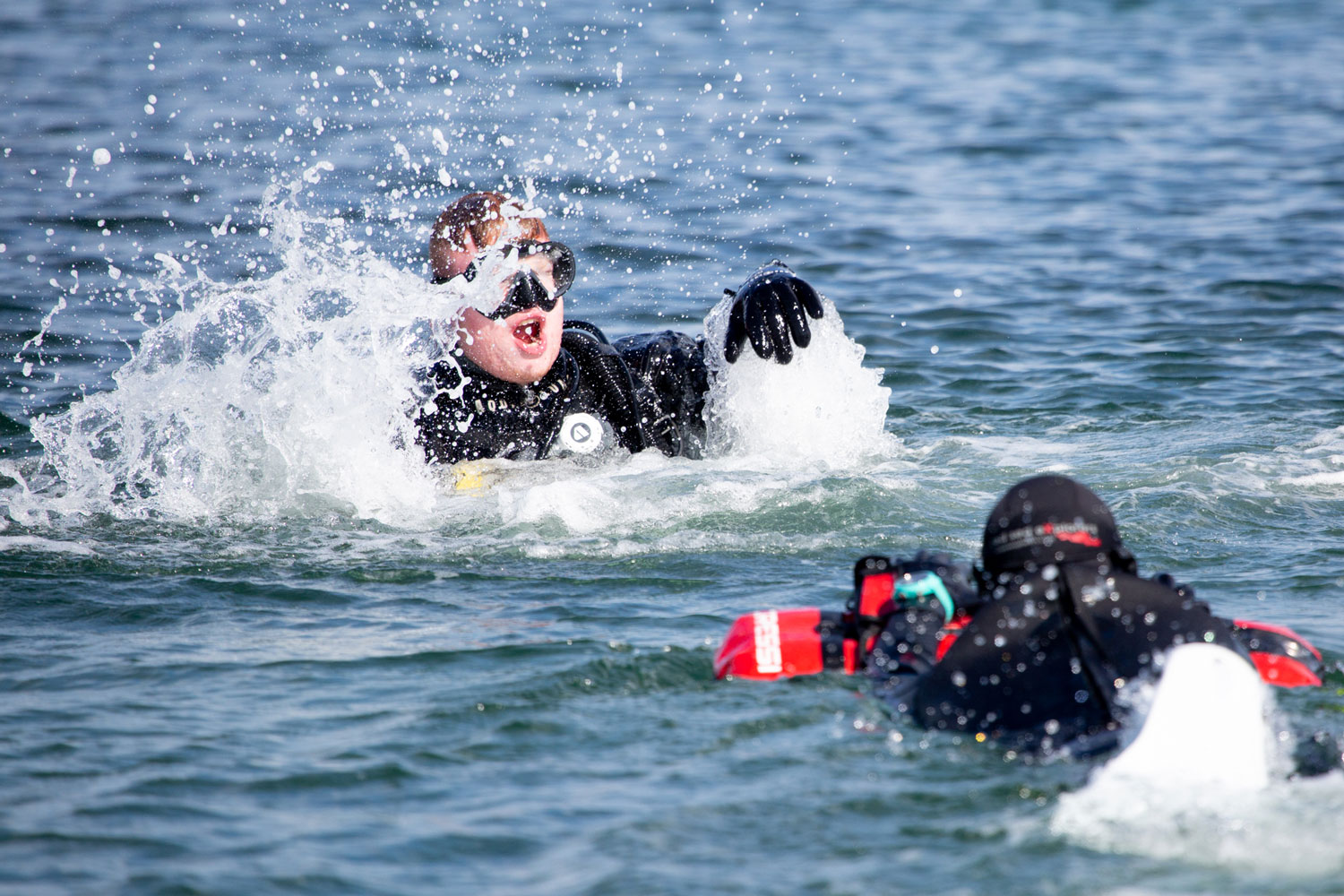
Credit: The Fifth Point Diving (photograph of rescue training and scenario practice)
The incident
It was sunny day, and probably the best conditions we had seen all year, attracting lots of divers. There were multiple groups from various clubs and agencies. Our team was running courses, so we were quite busy. As all groups found space to set up for the day a sudden shout for ‘Help!’ came from the entrance to the water. Someone’s shore cover dashed towards the water with a first aid kit. At first, it looked like a training exercise, and we hoped it was. The shore cover’s actions seemed to confirm this, but the situation was unclear. With our awareness of effective communication we asked clearer questions and soon found out this was a real emergency. One diver was unconscious on the surface, and their buddy was shouting for assistance.
Our team, trained in realistic, scenario-based exercises at these shore sites, responded swiftly, as did other divers. A few healthcare professionals who happened to be diving that day also stepped forward. Many divers helped pull the victim from the water, and CPR was begun as soon as possible. By this point, one of our staff had called emergency services and others had brought our oxygen and first aid-kit. A team formed around the victim, providing first aid, while others supported and checked on the buddy.
The police and ambulance crew arrived, which was a relief. They continued resuscitation and provided advanced life support while we continued to take turns at CPR. Then the coastguard arrived by boat and helicopter. Rescue and emergency services personnel were everywhere, responding to the victim and looking after the rest of us, handing out water and ensuring no one was at risk of hypothermia or shock.
Tragically, it was not the outcome we wanted. We later learned that the victim had likely suffered a medical event before entering the water, succumbed early in the dive and did not regain consciousness after being pulled from the water.
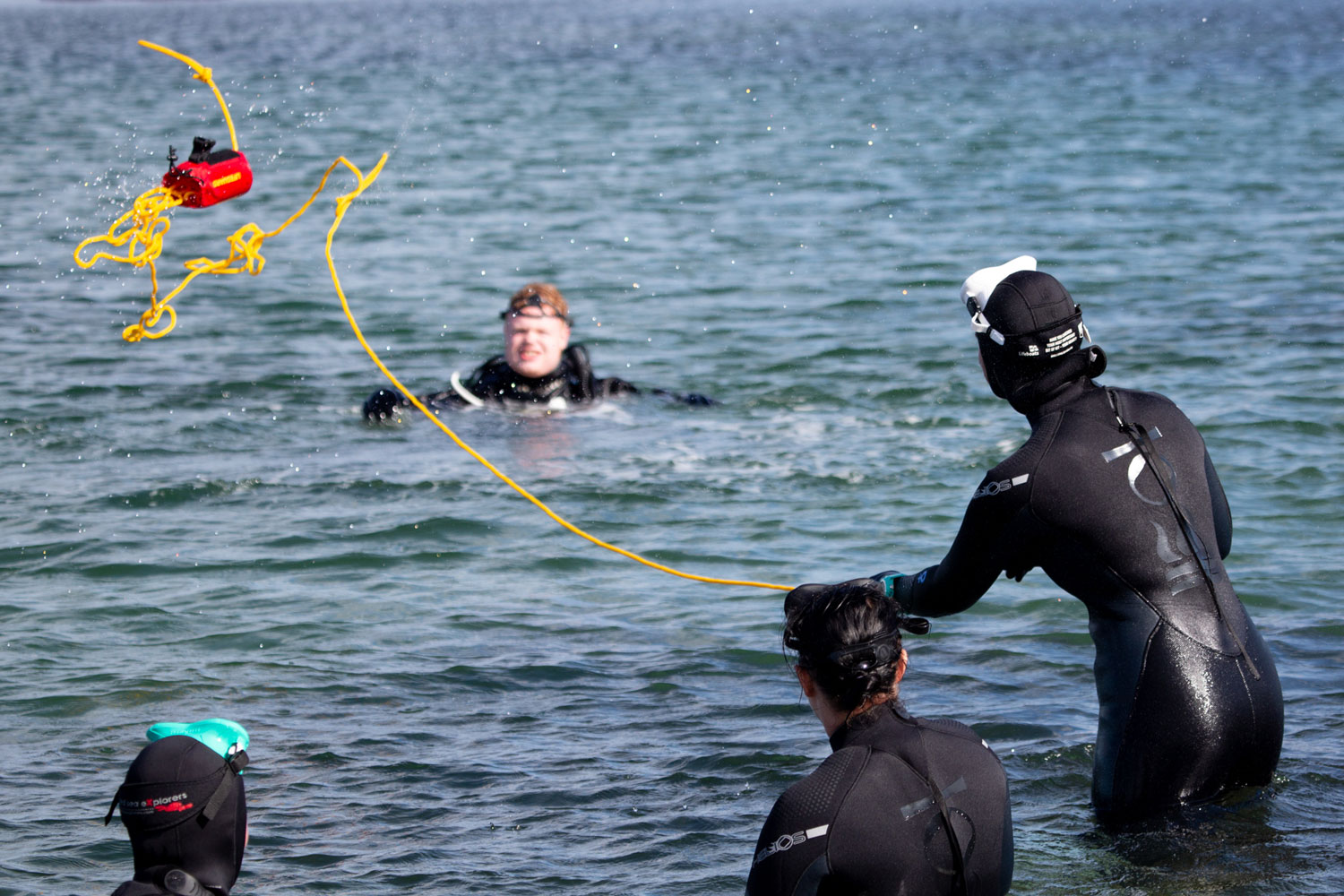
Credit: The Fifth Point Diving (photograph of rescue training and scenario practice)
More than one victim
That day there were divers of various levels of experience: novices, some on their first dives; seasoned cold water divers; and diving professionals from multiple agencies. There were also associated onlookers, relatives of divers who had come for a day out. Being on the coast there were people walking by with their dogs and children. As the event unfolded, emergency services brought more people, some volunteers who will have responded to the call.
Although one individual diver was the direct victim, there were many people who were impacted. Some of whom more at risk of the psychological effects of trauma. Most notably, in such an event the buddy, friends and relatives of the diver are affected. Where someone is severely hurt or dies in a diving incident, those who know the person are often impacted not only by the loss, but sometimes the trauma of their own experience. For example, relatives who were not present at the incident may still be troubled by mental images of the distressing thing that happened to their loved one, because our brains can create such memories. In this case, we quickly became aware that the buddy was a close relative of the victim, as well as a rescuer who had ascended quickly.
Rescuers, whether they know the victim or not, can be at risk of psychological injury. Being physically near to the victim, possibly for extended periods, rescuers are exposed to potentially distressing conditions. Sometimes the rescuer is at risk of physical harm too. During this event, I did not sense that neither I, nor anyone other than the two divers, was at risk of immediate physical harm as a rescuer. However, that is not always the case. A diver bringing an unconscious or panicking diver to the surface, or heading deeper to rescue someone from an uncontrolled descent, is more likely to have perceived a real threat to their own survival. Similarly, there are events where multiple divers are hurt in the same incident.
Although there is great variance in the level of risk, psychological injury is a possible outcome for those involved. The development of conditions such as post-traumatic stress depends on numerous factors such as: the person’s experience of the event; any previous history of trauma; their role (e.g. trained professional, bystander); their relationship to the victim(s); the circumstances of what happened and how they reacted at the time.
Restoring safety and returning to normality
After our part in the emergency was over, our team congregated near our van, all of us affected by what had happened. We took some time to check on one another before deciding to return to our centre to rest, as well as involve the more of the team. (One of the owner-managers had been on site, the other at the centre doing admin and we wanted to get back to them and closer to home). The journey back was quiet, reflective. Upon arrival, we slumped down and given some snacks and drinks and generally looked after. We were all willing to debrief at that point, which we did focusing primarily on the details of what had happened, what aspects were handled well, and what lessons could be learned from the experience. We made sure to check that everyone was coping okay.
It is important to note here, there are a lot of issues surrounding the question of debriefs after trauma, it’s a complex topic I have explored in detail here. An important feature is psychological safety. If you go through an event like this with people you do not feel safe with, the trauma can be exacerbated. For example, if the debrief turns into blaming or over-sharing behaviour, then that could overwhelm and already wobbly nervous system. It leads to more shutting down, more avoidance behaviours and outward defensiveness. Where there is high psychological safety, with appropriate accountability, the trust, connection and effective communication can be the soft-landing place where everyone can begin to heal.
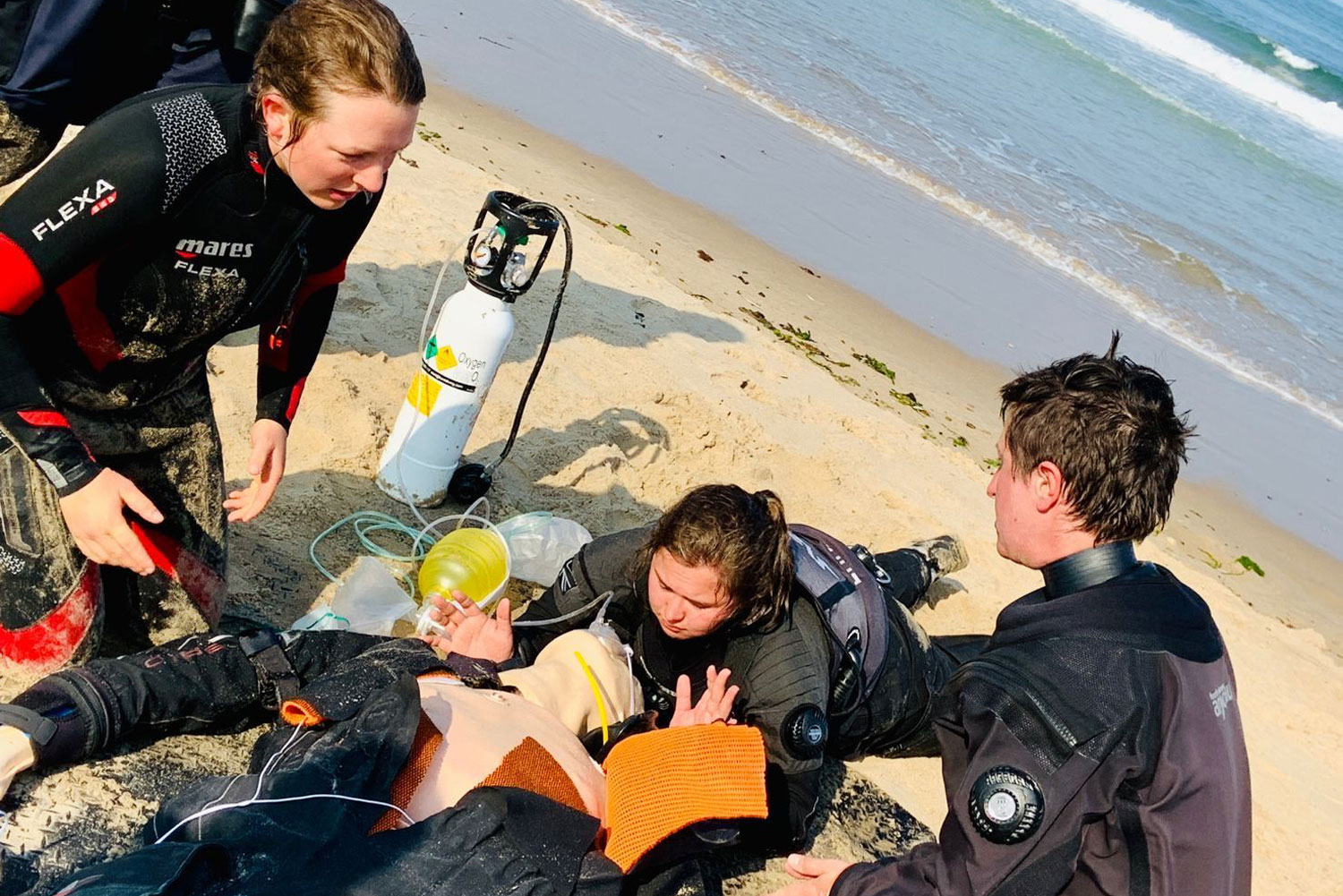
Credit: Life Saving Training – scenario practice
In the following week, we continued to check in on each other. Forms of emotional release, such as shedding tears, were noted to occur on returning home or recounting the event. I, like several others, especially those who had participated in the CPR, experienced intense images and sensations in the days that followed. This gradually eased as time passed.
Processing the Event
When we encounter a traumatic event, our primary focus shifts to survival, whether it’s our own or that of the people we’re rescuing. During such times, the brain doesn’t have time to fully process the barrage of sights, sounds, sensations, thoughts, and images that flood our system. This is why, after a distressing event, there is the need to process these thoughts, images, and the emotions tied to them.
Think of it as a wave. Normally, an event triggers an emotional and physical response—like anger or fear—which then gradually subsides. However, in a traumatic situation, it’s as if these waves are held back. Post-event, it can feel like a dam has burst, releasing emotions, images, and thoughts seemingly at random. This can manifest as nightmares, flashbacks, irritability, or unexpected tears.
For instance, I found myself bombarded with images, initially the more disturbing ones from the event. And I was not the only one, others who had been there said the same. As I allowed these images to surface and fade, gradually, more positive or neutral images emerged, like a kind facial expression or the seaweed on the rocks. While this was an unusual experience for me, my professional background helped me understand it as the brain’s way of sorting its ‘files.’ It’s useful to let this process happen, to notice and feel the emotions attached to these images until they pass.
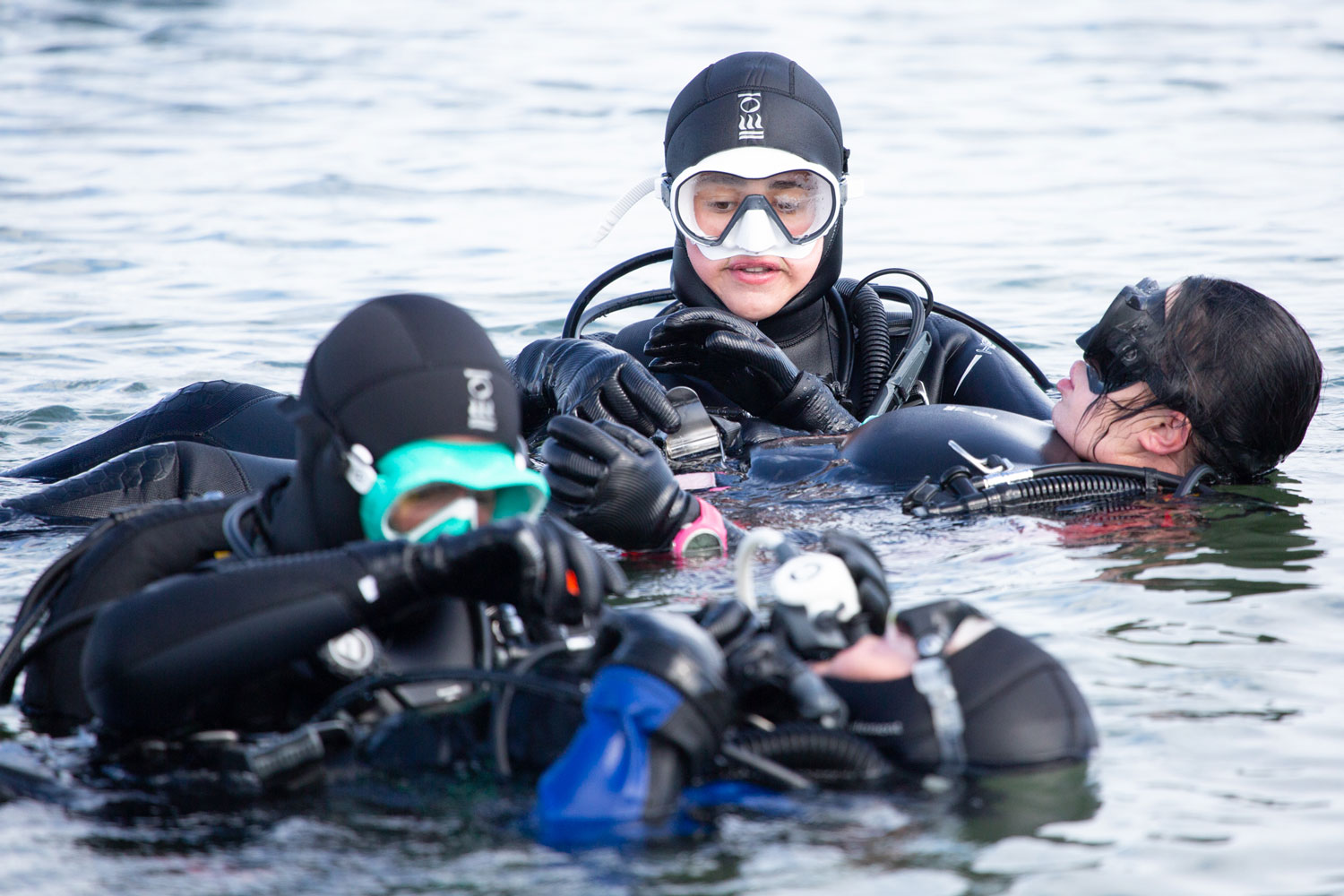
Credit: The Fifth Point Diving (photograph of rescue training and scenario practice)
Acknowledging and letting go of these experiences is crucial. There are various ways to support this process, as outlined in the ‘self-help/signposting’ section. Methods like talking, therapy, or walking can be beneficial. A key aspect is returning to a safe place. If our system still perceives a threat, defenses stay up, preventing us from processing these difficult experiences. When these experiences remain unprocessed, they can lead to problems later on.
Narratives: the role of shaping our stories
Central to processing a traumatic event is how we make sense of what happened. It’s natural to replay the event in your mind, questioning your actions and decisions. Did you do the right thing? Was anything your fault?
In my work with individual’s post-trauma, I often find that it’s the narrative they’ve constructed that causes issues: thoughts like ‘It was my fault’ or ‘I should have done something different,’ or feelings of ongoing danger and lack of control. These narratives can also trigger issues related to self-worth. Often, these narratives become entrenched when there are pre-existing trauma issues.
One thing that can help reshape these narratives is having accurate information about what happened. Our team was fortunate to receive extensive feedback from off-duty health professionals who were diving that day, as well as from our first aid trainers who reviewed our report. They confirmed that we had acted as trained, which was immensely reassuring. This feedback was not just about confirming our actions; it helped shape our collective narrative: ‘We did everything we could.’ Even though the outcome wasn’t what we hoped for, our process was sound, which helped protect us from self-critical and negative judgments that can impact mental health.
Of course, there are instances where a mistake or a specific action contributes to an adverse event. However, damaging self-cognitions can form even without a direct mistake, often rooted in pre-existing issues like self-worth. Given the human mind’s tendency towards negative appraisal, it is common for distressing experiences to stir up unhelpful self-stories such as: “I am useless” or “I am a bad person”. When things go wrong, we also tend towards ways of thinking that can go around in loops, worry and rumination, often getting hooked in solutions that do not change the reality of what happened.

Credit: The Fifth Point Diving (photograph of rescue training and scenario practice)
Sharing perspectives during the debrief can be incredibly helpful. For example, when I saw many people rushing to the water to assist the victim, I chose to stay back and instruct our group of novices. I let our divers know the situation and advised them to remove their kit to avoid overheating. Had I not discussed this during the debrief, I might have questioned my decision, and been left feeling I should have went to the water. However, the team agreed it was a useful decision, ensuring all bases were covered: someone calling for help, another getting the first aid kit, two assisting the victim, and one ensuring the safety of our divers.
Similarly, a person calling for help and staying on the phone to emergency services while others are working hands-on may wonder if they did much. However, as well as the vital act of summoning help and relaying information, having someone in that role supports the whole team. I can recall looking up at the cliffs above and being reassured that they were getting help to us. It gave motivation to keep going. This was one of many examples in our debrief where someone was unsure of their actions, but from others’ perspectives, their contributions were invaluable. Having a core narrative of “I helped”, “I survived” or “We did what I could” is adaptive and protects against the negative impacts of trauma. Where there is fault, and mistakes have been made, a healthy narrative may be “I have learned from my mistake”.
Recovery: Healing and (possibly) returning to diving
An event such as this impacts a large number of people and level of impact is wide-ranging. For some divers, particularly where the outcome of the event was significant injury or loss of someone close, then returning to diving may not be possible, or desirable or both. The trauma is pervasive, and recovery means not only processing what happened, but also living with loss and grief. There is a distinct difference between trauma and loss, healing means adaptation and trauma memories can fade; but grief is ongoing and is lived-with rather than overcome.
Where the outcome is less severe, where physical injuries are not permanent or for those who were not affected by personal loss, there is still a possibility of getting stalled in healing. This can often be more of a risk where the person has a previous issue that is unresolved. For example, early/childhood trauma relating to loss of agency or capability to respond is sometimes triggered. On the one hand, this is problematic because it is a hurdle to recovery. However, on the other hand it can be an opportunity. I have frequently worked with divers who have been struggling to resolve some aspect of a recent diving accident, and we realise that there are some similar unresolved events from their past. In addressing all of these, the person not only recovers from the diving event, they also heal old wounds.
Coming back to my story, like for most people, I did not get stuck. I am however acutely aware of the possibility of adverse events to get in the way of returning to diving. I have seen quite a few divers who witness an incident, then go on to have issues on their own dives and know some ways to minimise this risk. Luckily, we were all keen to dive again soon. We made sure our next dive was not too demanding. When we returned to that site, we continued to check in with each other. We had some enjoyable and uneventful diving. This helped in returning to the diver’s version of normality, which is a fundamental part of recovery. Anecdotally, and increasingly in research, diving itself can be helpful for mental wellbeing and healing from trauma.

Credit: The Fifth Point Diving
The good parts of the experience
I do not think I will ever not feel some discomfort when commenting on positive experiences in the context of trauma. To turn attention to the good parts of the terrible and tragic can risk minimising or glossing over what happened. But this is not what I mean, and it is so important to consider this aspect of trauma. In my work as a psychologist, one of the ways we know a person is healing is they spontaneously start to talk about aspects of what happened that were comforting, helpful or brought new insights. Many people who go through trauma also experience something called “post-traumatic growth”: the positive psychological change and personal development experienced after struggling with traumatic events. It does not mean being pleased something bad happened, but doing what you can with it. Looking for the good, while still acknowledging the bad, is an adaptive response to something we cannot change.
For me, in this experience, it was the helpers. One moment we were fighting for a bit of space, the next we were all one team: strangers working together in the attempt to save the life of a diver none of us knew. Within our team, everyone was looking after each other, as well as anyone else caught up in the crisis. Then the emergency services turned up and started looking after all of us. Bystanders giving out sandwiches. Everywhere you looked, someone was helping somebody.
On a practical level, following the debrief we identified a few useful changes and put those into action. As much as we hope something like this won’t happen again, but it helps to know that we are prepared to respond.
I hope that sharing this story is useful in raising awareness of psychological trauma in diving, and the measures the help to prevent and mitigate the impact of such devastating events.
About the author
Laura Walton is a clinical psychologist and scuba diving instructor bringing together psychology and scuba diving to help people with their diving. She provides specialist psychological services for scuba divers and accessible courses. Laura has been guiding and teaching scuba diving in the UK since 2012, and is currently a PADI IDC Staff Instructor at The Fifth Point Diving Centre, Blyth, UK.


